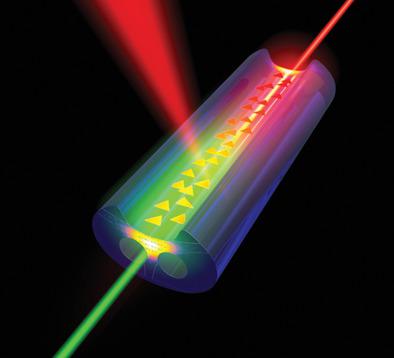当前位置:
X-MOL 学术
›
Adv. Mater.
›
论文详情
Our official English website, www.x-mol.net, welcomes your feedback! (Note: you will need to create a separate account there.)
Scalable Functionalization of Optical Fibers Using Atomically Thin Semiconductors
Advanced Materials ( IF 29.4 ) Pub Date : 2020-10-06 , DOI: 10.1002/adma.202003826 Gia Quyet Ngo 1 , Antony George 2 , Robin Tristan Klaus Schock 1 , Alessandro Tuniz 3 , Emad Najafidehaghani 2 , Ziyang Gan 2 , Nils C. Geib 1 , Tobias Bucher 1 , Heiko Knopf 1, 4, 5 , Sina Saravi 1 , Christof Neumann 2 , Tilman Lühder 6 , Erik P. Schartner 7 , Stephen C. Warren‐Smith 7 , Heike Ebendorff‐Heidepriem 7 , Thomas Pertsch 1, 4, 5 , Markus A. Schmidt 6 , Andrey Turchanin 2 , Falk Eilenberger 1, 4, 5
Advanced Materials ( IF 29.4 ) Pub Date : 2020-10-06 , DOI: 10.1002/adma.202003826 Gia Quyet Ngo 1 , Antony George 2 , Robin Tristan Klaus Schock 1 , Alessandro Tuniz 3 , Emad Najafidehaghani 2 , Ziyang Gan 2 , Nils C. Geib 1 , Tobias Bucher 1 , Heiko Knopf 1, 4, 5 , Sina Saravi 1 , Christof Neumann 2 , Tilman Lühder 6 , Erik P. Schartner 7 , Stephen C. Warren‐Smith 7 , Heike Ebendorff‐Heidepriem 7 , Thomas Pertsch 1, 4, 5 , Markus A. Schmidt 6 , Andrey Turchanin 2 , Falk Eilenberger 1, 4, 5
Affiliation

|
Atomically thin transition metal dichalcogenides are highly promising for integrated optoelectronic and photonic systems due to their exciton‐driven linear and nonlinear interactions with light. Integrating them into optical fibers yields novel opportunities in optical communication, remote sensing, and all‐fiber optoelectronics. However, the scalable and reproducible deposition of high‐quality monolayers on optical fibers is a challenge. Here, the chemical vapor deposition of monolayer MoS2 and WS2 crystals on the core of microstructured exposed‐core optical fibers and their interaction with the fibers’ guided modes are reported. Two distinct application possibilities of 2D‐functionalized waveguides to exemplify their potential are demonstrated. First, the excitonic 2D material photoluminescence is simultaneously excited and collected with the fiber modes, opening a novel route to remote sensing. Then it is shown that third‐harmonic generation is modified by the highly localized nonlinear polarization of the monolayers, yielding a new avenue to tailor nonlinear optical processes in fibers. It is anticipated that the results may lead to significant advances in optical‐fiber‐based technologies.
中文翻译:

使用原子薄半导体的光纤可扩展功能化
原子稀薄的过渡金属二卤化物因受激子驱动的与光的线性和非线性相互作用,因此在集成的光电和光子系统中非常有前途。将它们集成到光纤中为光通信,遥感和全光纤光电子学带来了新的机遇。但是,在光纤上可扩展且可重现的高质量单层沉积是一个挑战。在此,单层MoS 2和WS 2的化学气相沉积报道了微结构裸露光纤芯线上的晶体以及它们与光纤引导模式的相互作用。演示了二维功能化波导的两种不同应用可能性,以例证其潜力。首先,激子2D材料的光致发光同时激发并通过纤维模式收集,从而为遥感开辟了一条新途径。然后表明,三次谐波的产生被单层的高度局部化的非线性偏振所修饰,从而为调整光纤中的非线性光学过程提供了一条新途径。预计结果可能会导致基于光纤的技术取得重大进步。
更新日期:2020-11-25
中文翻译:

使用原子薄半导体的光纤可扩展功能化
原子稀薄的过渡金属二卤化物因受激子驱动的与光的线性和非线性相互作用,因此在集成的光电和光子系统中非常有前途。将它们集成到光纤中为光通信,遥感和全光纤光电子学带来了新的机遇。但是,在光纤上可扩展且可重现的高质量单层沉积是一个挑战。在此,单层MoS 2和WS 2的化学气相沉积报道了微结构裸露光纤芯线上的晶体以及它们与光纤引导模式的相互作用。演示了二维功能化波导的两种不同应用可能性,以例证其潜力。首先,激子2D材料的光致发光同时激发并通过纤维模式收集,从而为遥感开辟了一条新途径。然后表明,三次谐波的产生被单层的高度局部化的非线性偏振所修饰,从而为调整光纤中的非线性光学过程提供了一条新途径。预计结果可能会导致基于光纤的技术取得重大进步。



























 京公网安备 11010802027423号
京公网安备 11010802027423号